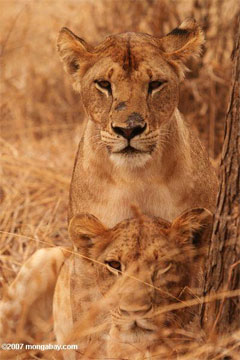Lion die-offs in Africa linked to global warming
Lion die-offs in Africa linked to global warming
mongabay.com
June 26, 2008
|
|
Scientists have linked climate shifts in East Africa to die-offs in lion populations in 1994 and 2001. The research is published in the open-access journal PLoS ONE.
Analyzing 30 years of data on lion populations and comparing it with precipitation records, an international team researchers found that periods of extreme drought followed by heavy seasonal rains in 1994 and 2001 created conditions for a duel outbreak of canine distemper virus (CDV) and tick-borne Babesia, diseases that periodically affect lion populations, but typically occur in isolation, resulting in limited mortality. The synchronized infections killed about a third of lions in the Serengeti in 1994 and nearly 40 percent of the population in Ngorongoro Crater in 2001.
The researchers found that while lion populations are typically resilient to CDV outbreaks in isolation, the two die-offs were preceded by extreme droughts which weakened and left lion prey like Cape buffalo susceptible to infection by Babesia-carrying ticks. The lions feasted on the weakened prey but the co-infection that resulted from the feeding bonanza proved catastrophic.

|
“Epidemics are usually presumed to be caused by single pathogens, a premise that may in some circumstances be overly simplistic. Temporal and spatial convergence of several infectious agents under environmental conditions that favor their transmission and propagation could create a “perfect storm” of pathogens, resulting in significantly greater mortality,” write the authors. “Here we present the first data to clearly illustrate how climate extremes can promote a complex interplay between epidemic and endemic pathogens that are normally tolerated in isolation, but with co-infection, result in catastrophic mortality.”
The researchers warn that similar interplay is likely occurring elsewhere and may worsen with climate change.
“With global warming, there is considerable concern that ecological patterns of disease will be altered, as has occurred with the recent high mortality epidemics in amphibia and corals,” they write, noting that the recent colony collapse disorder in honeybees is another example of co-infection.
Munson L, Terio KA, Kock R, Mlengeya T, Roelke ME, et al. (2008) Climate Extremes Promote Fatal Co-Infections during Canine Distemper Epidemics in African Lions. PLoS ONE 3(6): e2545 doi:10.1371/journal.pone.0002545